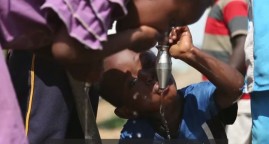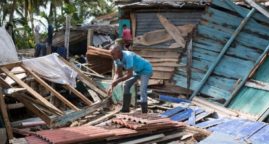Which countries are most at risk from climate change and how can we help?
The countries most vulnerable to climate change are among the poorest and least able to respond.
How to resolve that dilemma and help these places adapt to a warming world remains among the knottiest problems facing climate financing.
The good news is that identifying those most in need – step one – is now a good deal easier thanks to a global league table developed by the University of Notre Dame.
The Notre Dame Global Adaptation Index (ND-GAIN) measures a country’s vulnerability in relation to its ability to cope with climate change.
It calculates exposure to climate stress (for example a reliance on agriculture); sensitivity to the impact of climate shocks; and adaptive capacity. It then scores a country’s readiness – defining that in terms of a willingness to leverage its economic, governance and social resources to reduce climate risk.
According to the index, the world’s five worst performers are Eritrea, Chad, Central African Republic, Sudan and the Democratic Republic of the Congo. By comparison, the over-achievers – and you’d guess at least a couple of them – are New Zealand, Norway, Denmark, the United Kingdom and Germany, in that order.
Hooray for Paris
One of the important outcomes of the Paris climate summit in December was the recognition that reducing greenhouse gasses is not enough. Adaptation – how to live with a warming world – is now also accepted as key, and there is a greater realisation that poorer countries will need support to help achieve that.
Paris affirmed the financing target of $100 billion a year from public and private sources by 2020. A game-changer could also be the Green Climate Fund, which will devote 50 percent of all its funding to adaptation, which has historically been overshadowed by spending on mitigation projects like renewable energy.
“Paris was wonderful, but what’s really important now is what happens on the ground,” said Koko Warner, of the United Nations University’s Institute for Environment and Human Security. “The true yardstick of success is in these highly vulnerable countries.”
Money alone will not be enough to build climate security. “The question of access [to financing] is not a simple answer as it concerns multiple challenges including technical capacity to develop bankable proposals, [tackle the] knowledge and capacity gaps, and provide access to resources needed to do the necessary feasibility studies,” Barbara Buchner of the Climate Policy Initiative said in an emailed response.
“We need to find ways to increase the absorptive capacity of countries that need the funding the most, and harmonise investment standards, transparency and governance issues,” noted Warner. “We need more nuance on how to deliver financing to really help the poor, to unravel the knots around climate impact and livelihoods.”
That needs to happen quickly, because the estimates are that the true climate bill will be in the trillions rather than billions of dollars – especially if the world cannot keep below two degrees Celsius of global warming agreed in Paris.
“We know that public resources in all countries are stretched, and that $100 billion will not satisfy the needs on the ground,” said Buchner. “It is therefore essential that the $100 billion be spent wisely. If we can do this, much more private investment will flow.”
Read the full article on IRIN website
Related Articles
Interview with Pedro Medrano Rojas, UN Senior Coordinator for the Cholera Response in Haiti
03/04/2015. The persistence of cholera in Haiti is mainly due to the lack of access to clean water and appropriate sanitation facilities …
When life hangs by a glass of drinking water
03/22/2016. The ravages of unsafe water are unexpected.
5 natural disasters that beg for climate action
Climate hazards are natural events in weather cycles. We are currently witnessing a scale of destruction and devastation that is new and terrifying.






